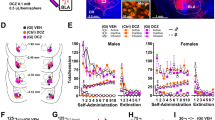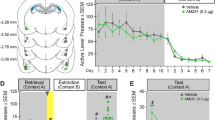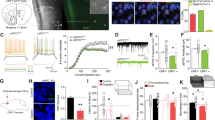Abstract
We previously showed that betaxolol, a selective β1-adrenergic receptor antagonist, administered during early phases of cocaine abstinence, ameliorated withdrawal-induced anxiety and blocked increases in amygdalar β1-adrenergic receptor expression in rats. Here, we report the efficacy of betaxolol in reducing increases in gene expression of amygdalar corticotropin-releasing factor (CRF), a peptide known to be involved in mediating ‘anxiety-like’ behaviors during initial phases of cocaine abstinence. We also demonstrate attenuation of an amygdalar β1-adrenergic receptor-mediated cell-signaling pathway following this treatment. Male rats were administered betaxolol at 24 and 44 h following chronic cocaine administration. Animals were euthanized at the 48-h time point and the amygdala was microdissected and processed for quantitative reverse transcriptase-polymerase chain reaction and/or western blot analysis. Results showed that betaxolol treatment during early cocaine withdrawal attenuated increases in amygdalar CRF gene expression and cyclic adenosine monophosphate-dependent protein kinase regulatory and catalytic subunit (nuclear fraction) protein expression. Our data also reveal that β1-adrenergic receptors are on amygdalar neurons, which are immunoreactive for CRF. The present findings suggest that the efficacy of betaxolol treatment on cocaine withdrawal-induced anxiety may be related, in part, to its effect on amygdalar β1-adrenergic receptor, modulation of its downstream cell-signaling elements and CRF gene expression.
Similar content being viewed by others
Log in or create a free account to read this content
Gain free access to this article, as well as selected content from this journal and more on nature.com
or
Abbreviations
- BLA:
-
basolateral nucleus of the amygdala
- BSA:
-
bovine serum albumin
- cAMP:
-
cyclic adenosine monophosphate
- CNA:
-
central nucleus of the amygdala
- CREB:
-
cAMP response element-binding protein
- CRF:
-
corticotropin-releasing factor
- GAPDH:
-
glyceraldehyde-3-phosphate-dehydrogenase
- PB:
-
phosphate buffer
- PBS:
-
phosphate-buffered saline
- pCREB:
-
phosphorylated CREB
- PKA:
-
cyclic AMP-dependent protein kinase
- qRT-PCR:
-
quantitative reverse transcriptase-polymerase chain reaction
- TS:
-
tris-saline buffer
References
Alberts B, Johnson A, Lewis J, Raff M, Roberts K, Walter P (2002). Cell communication. In: Anderson MS, Dilernia B (eds). Molecular Biology of the Cell. Garland Science: New York. pp 831–906.
Asyyed A, Storm D, Diamond I (2006). Ethanol activates cAMP response element-mediated gene expression in select regions of the mouse brain. Brain Res 1106: 63–71.
Berke JD, Hyman SE (2000). Addiction, dopamine, and the molecular mechanisms of memory. Neuron 25: 515–532.
Beveridge TJ, Smith HR, Nader MA, Porrino LJ (2005). Effects of chronic cocaine self-administration on norepinephrine transporters in the nonhuman primate brain. Psychopharmacology (Berl) 180: 781–788.
Bourgeais L, Gauriau C, Bernard JF (2001). Projections from the nociceptive area of the central nucleus of the amygdala to the forebrain: a PHA-L study in the rat. Eur J Neurosci 14: 229–255.
Bruijnzeel AW, Gold MS (2005). The role of corticotropin-releasing factor-like peptides in cannabis, nicotine, and alcohol dependence. Brain Res Brain Res Rev 49: 505–528.
Bruijnzeel AW, Zislis G, Wilson C, Gold MS (2007). Antagonism of CRF receptors prevents the deficit in brain reward function associated with precipitated nicotine withdrawal in rats. Neuropsychopharmacology 32: 955–963.
Clayton EC, Williams CL (2000). Adrenergic activation of the nucleus tractus solitarius potentiates amygdala norepinephrine release and enhances retention performance in emotionally arousing and spatial memory tasks. Behav Brain Res 112: 151–158.
Dunn AJ, Swiergiel AH, Palamarchouk V (2004). Brain circuits involved in corticotropin-releasing factor-norepinephrine interactions during stress. Ann NY Acad Sci 1018: 25–34.
Erb S, Salmaso N, Rodaros D, Stewart J (2001). A role for the CRF-containing pathway from central nucleus of the amygdala to bed nucleus of the stria terminalis in the stress-induced reinstatement of cocaine seeking in rats. Psychopharmacology (Berl) 158: 360–365.
Fuchs RA, See RE (2002). Basolateral amygdala inactivation abolishes conditioned stimulus- and heroin-induced reinstatement of extinguished heroin-seeking behavior in rats. Psychopharmacology (Berl) 160: 425–433.
Gawin FH, Kleber HD (1986). Abstinence symptomatology and psychiatric diagnosis in cocaine abusers. Clinical observations. Arch Gen Psychiatry 43: 107–113.
Gonzalez GA, Montminy MR (1989). Cyclic AMP stimulates somatostatin gene transcription by phosphorylation of CREB at serine 133. Cell 59: 675–680.
Gonzalez GA, Menzel P, Leonard J, Fischer WH, Montminy MR (1991). Characterization of motifs which are critical for activity of the cyclic AMP-responsive transcription factor CREB. Mol Cell Biol 11: 1306–1312.
Gray EG (1959). Axo-somatic and axo-dendritic synapses of the cerebral cortex: an electron microscope study. J Anat 93: 420–433.
Hardman JG, Limbird LE, Goodman Gilman A (eds). (2001). In: Goodman & Gilman's The Pharmacological Basis of Therapeutics. McGraw-Hill: New York.
Harris GC, Aston-Jones G (1993). Beta-adrenergic antagonists attenuate withdrawal anxiety in cocaine- and morphine-dependent rats. Psychopharmacology (Berl) 113: 131–136.
Hatalski CG, Baram TZ (1997). Stress-induced transcriptional regulation in the developing rat brain involves increased cyclic adenosine 3′,5′-monophosphate-regulatory element binding activity. Mol Endocrinol 11: 2016–2024.
Hellemans KG, Everitt BJ, Lee JL (2006). Disrupting reconsolidation of conditioned withdrawal memories in the basolateral amygdala reduces suppression of heroin seeking in rats. J Neurosci 26: 12694–12699.
Itoi K, Horiba N, Tozawa F, Sakai Y, Sakai K, Abe K et al (1996). Major role of 3′,5′-cyclic adenosine monophosphate-dependent protein kinase A pathway in corticotropin-releasing factor gene expression in the rat hypothalamus in vivo. Endocrinology 137: 2389–2396.
Jentsch JD, Olausson P, Nestler EJ, Taylor JR (2002). Stimulation of protein kinase a activity in the rat amygdala enhances reward-related learning. Biol Psychiatry 52: 111–118.
Johannessen M, Delghandi MP, Moens U (2004). What turns CREB on? Cell Signal 16: 1211–1227.
Kampman KM, Volpicelli JR, Mulvaney F, Alterman AI, Cornish J, Gariti P et al (2001). Effectiveness of propranolol for cocaine dependence treatment may depend on cocaine withdrawal symptom severity. Drug Alcohol Depend 63: 69–78.
Koh KK, Song JH, Kwon KS, Park HB, Baik SH, Park YS et al (1995). Comparative study of efficacy and safety of low-dose diltiazem or betaxolol in combination with digoxin to control ventricular rate in chronic atrial fibrillation: randomized crossover study. Int J Cardiol 52: 167–174.
Koob GF (1999). Corticotropin-releasing factor, norepinephrine, and stress. Biol Psychiatry 46: 1167–1180.
Koob GF, Bloom FE (1988). Cellular and molecular mechanisms of drug dependence. Science 242: 715–723.
Koob GF, Heinrichs SC (1999). A role for corticotropin releasing factor and urocortin in behavioral responses to stressors. Brain Res 848: 141–152.
Kovacs KJ, Sawchenko PE (1996a). Regulation of stress-induced transcriptional changes in the hypothalamic neurosecretory neurons. J Mol Neurosci 7: 125–133.
Kovacs KJ, Sawchenko PE (1996b). Sequence of stress-induced alterations in indices of synaptic and transcriptional activation in parvocellular neurosecretory neurons. J Neurosci 16: 262–273.
Kreibich AS, Blendy JA (2004). cAMP response element-binding protein is required for stress but not cocaine-induced reinstatement. J Neurosci 24: 6686–6692.
Kreibich AS, Blendy JA (2005). The role of cAMP response element-binding proteins in mediating stress-induced vulnerability to drug abuse. Int Rev Neurobiol 65: 147–178.
Kwintkiewicz J, Cai Z, Stocco C (2007). Follicle-stimulating hormone-induced activation of Gata4 contributes in the up-regulation of Cyp19 expression in rat granulosa cells. Mol Endocrinol 21: 933–947.
Leranth C, Pickel VM (1989). Electron microscopic preembedding double-immunostaining methods. In: Heimer L, Zaborszky L (eds). Neuroanatomical Tract-Tracing Methods 2. Plenum Press: New York. pp 129–166.
Leri F, Flores J, Rodaros D, Stewart J (2002). Blockade of stress-induced but not cocaine-induced reinstatement by infusion of noradrenergic antagonists into the bed nucleus of the stria terminalis or the central nucleus of the amygdala. J Neurosci 22: 5713–5718.
Li J, Takeda H, Tsuji M, Liu L, Matsumiya T (1998). Antagonism of central CRF systems mediates stress-induced changes in noradrenaline and serotonin turnover in rat brain regions. Methods Find Exp Clin Pharmacol 20: 409–417.
Livak KJ, Schmittgen TD (2001). Analysis of relative gene expression data using real-time quantitative PCR and the 2(-Delta Delta C(T)) method. Methods 25: 402–408.
Lynch WJ, Taylor JR (2005). Persistent changes in motivation to self-administer cocaine following modulation of cyclic AMP-dependent protein kinase A (PKA) activity in the nucleus accumbens. Eur J Neurosci 22: 1214–1220.
Maj M, Turchan J, Smialowska M, Przewlocka B (2003). Morphine and cocaine influence on CRF biosynthesis in the rat central nucleus of amygdala. Neuropeptides 37: 105–110.
Mann SJ, Gerber LM (2001). Low-dose alpha/beta blockade in the treatment of essential hypertension. Am J Hypertens 14: 553–558.
Mayr B, Montminy M (2001). Transcriptional regulation by the phosphorylation-dependent factor CREB. Nat Rev Mol Cell Biol 2: 599–609.
McFarland K, Davidge SB, Lapish CC, Kalivas PW (2004). Limbic and motor circuitry underlying footshock-induced reinstatement of cocaine-seeking behavior. J Neurosci 24: 1551–1560.
Menzaghi F, Rassnick S, Heinrichs S, Baldwin H, Pich EM, Weiss F et al (1994). The role of corticotropin-releasing factor in the anxiogenic effects of ethanol withdrawal. Ann NY Acad Sci 739: 176–184.
Montminy M (1997). Transcriptional regulation by cyclic AMP. Annu Rev Biochem 66: 807–822.
Moore PA, Ozer J, Salunek M, Jan G, Zerby D, Campbell S et al (1999). A human TATA binding protein-related protein with altered DNA binding specificity inhibits transcription from multiple promoters and activators. Mol Cell Biol 19: 7610–7620.
Mosby (2006). Mosby's Drug Consult. Elsevier Mosby: St Louis.
NIDA (2007). National Institute on Drug Abuse http://www.nida.nih.gov.
Pandey SC, Roy A, Mittal N (2001). Effects of chronic ethanol intake and its withdrawal on the expression and phosphorylation of the creb gene transcription factor in rat cortex. J Pharmacol Exp Ther 296: 857–868.
Pandey SC, Zhang H, Roy A, Xu T (2005). Deficits in amygdaloid cAMP-responsive element-binding protein signaling play a role in genetic predisposition to anxiety and alcoholism. J Clin Invest 115: 2762–2773.
Pandey SC, Zhang H, Ugale R, Prakash A, Xu T, Misra K (2008). Effector immediate-early gene arc in the amygdala plays a critical role in alcoholism. J Neurosci 28: 2589–2600.
Paxinos G, Watson C (1986). The Rat Brain in Stereotaxic Coordinates. Academic Press: New York.
Peters A, Palay SL, Webster HDF (1991). General morphology of the neuron. In: The Fine Structure of the Nervous System: Neurons and Their Supporting Cells. Oxford University Press Inc.: New York. pp 3–13.
Pitkanen A (2000). Connectivity of the rat amygdaloid complex. In: Aggleton JP (ed). The Amygdala: A Functional Analysis. Oxford University Press: New York. pp 31–115.
Pollandt S, Liu J, Orozco-Cabal L, Grigoriadis DE, Vale WW, Gallagher JP et al (2006). Cocaine withdrawal enhances long-term potentiation induced by corticotropin-releasing factor at central amygdala glutamatergic synapses via CRF, NMDA receptors and PKA. Eur J Neurosci 24: 1733–1743.
Purves D, Augustine GJ, Fitzpatrick D, Katz LC, LaMantia A-S, McNamara JO et al (2001). Neuroscience. Sinauer Associates Inc., Sunderland, MA.
Robbins TW, Everitt BJ (1999). Drug addiction: bad habits add up. Nature 398: 567–570.
Robinson TE, Berridge KC (1993). The neural basis of drug craving: an incentive-sensitization theory of addiction. Brain Res Brain Res Rev 18: 247–291.
Rudoy CA, Van Bockstaele EJ (2006). Betaxolol, a selective beta(1)-adrenergic receptor antagonist, diminishes anxiety-like behavior during early withdrawal from chronic cocaine administration in rats. Prog Neuropsychopharmacol Biol Psychiatry 31: 1119–1129.
Sarnyai Z (1998). Neurobiology of stress and cocaine addiction. Studies on corticotropin-releasing factor in rats, monkeys, and humans. Ann NY Acad Sci 851: 371–387.
Sarnyai Z, Biro E, Gardi J, Vecsernyes M, Julesz J, Telegdy G (1995). Brain corticotropin-releasing factor mediates ‘anxiety-like’ behavior induced by cocaine withdrawal in rats. Brain Res 675: 89–97.
Sarnyai Z, Shaham Y, Heinrichs SC (2001). The role of corticotropin-releasing factor in drug addiction. Pharmacol Rev 53: 209–243.
Schultz J, Daly JW (1973). Accumulation of cyclic adenosine 3′, 5′-monophosphate in cerebral cortical slices from rat and mouse: stimulatory effect of alpha- and beta-adrenergic agents and adenosine. J Neurochem 21: 1319–1326.
Seasholtz AF, Thompson RC, Douglass JO (1988). Identification of a cyclic adenosine monophosphate-responsive element in the rat corticotropin-releasing hormone gene. Mol Endocrinol 2: 1311–1319.
See RE (2005). Neural substrates of cocaine-cue associations that trigger relapse. Eur J Pharmacol 526: 140–146.
Self DW, Genova LM, Hope BT, Barnhart WJ, Spencer JJ, Nestler EJ (1998). Involvement of cAMP-dependent protein kinase in the nucleus accumbens in cocaine self-administration and relapse of cocaine-seeking behavior. J Neurosci 18: 1848–1859.
Siegal GJ, Agranoff BW, Albers RW, Fisher SK, Uhler MD (eds). (1999). Basic Neurochemistry, Molecular, Cellular, and Medical Aspects. Lippincott, Williams & Wilkins: Philadelphia.
Swartz CM (1998). Betaxolol in anxiety disorders. Ann Clin Psychiatry 10: 9–14.
Thiele TE, Willis B, Stadler J, Reynolds JG, Bernstein IL, McKnight GS (2000). High ethanol consumption and low sensitivity to ethanol-induced sedation in protein kinase A-mutant mice. J Neurosci 20: RC75.
Valentino RJ, Foote SL, Page ME (1993). The locus coeruleus as a site for integrating corticotropin-releasing factor and noradrenergic mediation of stress responses. Ann NY Acad Sci 697: 173–188.
Valentino RJ, Page ME, Curtis AL (1991). Activation of noradrenergic locus coeruleus neurons by hemodynamic stress is due to local release of corticotropin-releasing factor. Brain Res 555: 25–34.
Van Bockstaele EJ, Pickel VM (1993). Ultrastructure of serotonin-immunoreactive terminals in the core and shell of the rat nucleus accumbens: cellular substrates for interactions with catecholamine afferents. J Comp Neurol 334: 603–617.
Van Bockstaele EJ, Peoples J, Valentino RJ (1999). A.E. Bennett Research Award. Anatomic basis for differential regulation of the rostrolateral peri-locus coeruleus region by limbic afferents. Biol Psychiatry 46: 1352–1363.
Van Bockstaele EJ, Pieribone VA, Aston-Jones G (1989). Diverse afferents converge on the nucleus paragigantocellularis in the rat ventrolateral medulla: retrograde and anterograde tracing studies. J Comp Neurol 290: 561–584.
Weiss F, Ciccocioppo R, Parsons LH, Katner S, Liu X, Zorrilla EP et al (2001). Compulsive drug-seeking behavior and relapse. Neuroadaptation, stress, and conditioning factors. Ann NY Acad Sci 937: 1–26.
Yao M, Stenzel-Poore M, Denver RJ (2007). Structural and functional conservation of vertebrate corticotropin-releasing factor genes: evidence for a critical role for a conserved cyclic AMP response element. Endocrinology 148: 2518–2531.
Zhou Y, Spangler R, Ho A, Kreek MJ (2003). Increased CRH mRNA levels in the rat amygdala during short-term withdrawal from chronic ‘binge’ cocaine. Brain Res Mol Brain Res 114: 73–79.
Acknowledgements
This work was supported by a predoctoral fellowship, NIH, National Institute on Drug Abuse (NIDA), Ruth L Kirschstein National Research Service Award (F31DA019311) to CR and DA15395 and DA009082 to EVB We thank Kristen Smith and Sarah Kidd for technical assistance.
Author information
Authors and Affiliations
Corresponding author
Additional information
DISCLOSURE/CONFLICT OF INTEREST
The authors would like to state that no prior, current, or pending conflict of interest exists for any of the authors (Carla A Rudoy, Arith-Ruth S Reyes, and Elisabeth J Van Bockstaele) pertaining to the research contained in the present paper submission. Furthermore, the authors declare that except for income received from their primary employer, no financial support or compensation has been received from any individual or corporate entity over the past 3 years for research or professional service and there are no personal financial holdings that could be perceived as constituting a potential conflict of interest.
Supplementary Information accompanies the paper on the Neuropsychopharmacology website (http://www.nature.com/npp)
Supplementary information
Rights and permissions
About this article
Cite this article
Rudoy, C., Reyes, AR. & Van Bockstaele, E. Evidence for β1-Adrenergic Receptor Involvement in Amygdalar Corticotropin-Releasing Factor Gene Expression: Implications for Cocaine Withdrawal. Neuropsychopharmacol 34, 1135–1148 (2009). https://doi.org/10.1038/npp.2008.102
Received:
Revised:
Accepted:
Published:
Issue date:
DOI: https://doi.org/10.1038/npp.2008.102
Keywords
This article is cited by
-
Paternal methamphetamine exposure induces higher sensitivity to methamphetamine in male offspring through driving ADRB1 on CaMKII-positive neurons in mPFC
Translational Psychiatry (2023)
-
Chronic REM Sleep Restriction in Juvenile Male Rats Induces Anxiety-Like Behavior and Alters Monoamine Systems in the Amygdala and Hippocampus
Molecular Neurobiology (2018)
-
Localization of the delta opioid receptor and corticotropin-releasing factor in the amygdalar complex: role in anxiety
Brain Structure and Function (2017)
-
Co-localization of the cannabinoid type 1 receptor with corticotropin-releasing factor-containing afferents in the noradrenergic nucleus locus coeruleus: implications for the cognitive limb of the stress response
Brain Structure and Function (2017)
-
Direct targeting of peptidergic amygdalar neurons by noradrenergic afferents: linking stress-integrative circuitry
Brain Structure and Function (2015)



